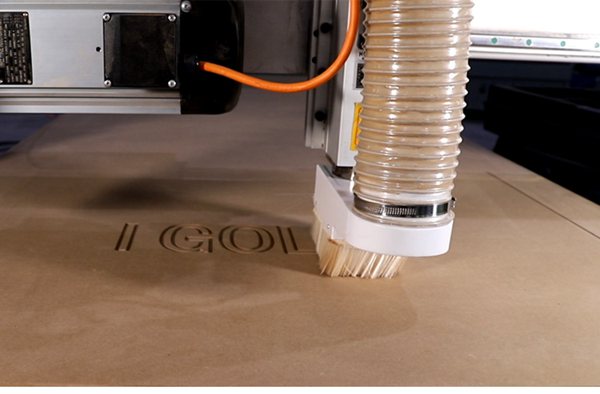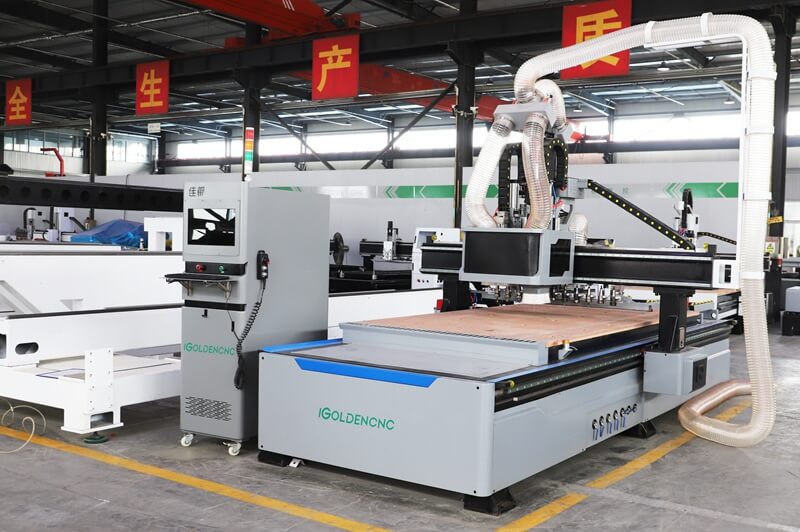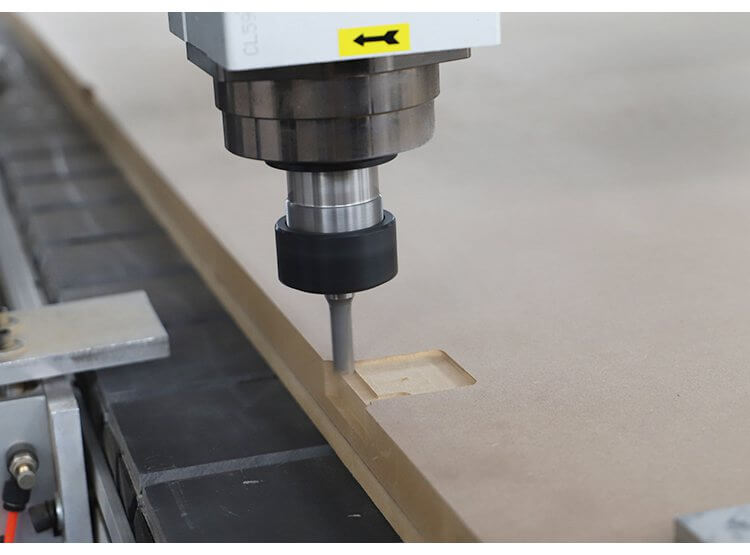Cutting Medium Density Fiberboard (MDF) on a CNC router has become a staple process for professionals and hobbyists in woodworking, cabinetry, and custom fabrication. MDF’s consistent composition and smooth surface make it ideal for intricate designs, decorative panels, furniture, and more. However, its dense fiber structure, combined with resin binders, poses challenges, such as excessive dust production, rapid tool wear, and the risk of edge chipping. To achieve precise cuts and preserve the life of your tools, you should understand the best techniques for working with MDF and the correct procedures for machine operation.

CNC Router Mdf Cutting Machine
A CNC router for MDF (Medium-Density Fiberboard) is a computer-controlled cutting machine designed for high-precision shaping, engraving, and milling of MDF sheets. These machines are widely used in furniture manufacturing, cabinetry, signage, and prototyping due to MDF’s smooth surface and ease of machining.



Medium Density Fiberboard (MDF) is an engineered wood product created by breaking down wood fibers from hardwood or softwood and combining them with wax and resin binders. These components are compressed under high pressure and heat to form dense, uniform panels with a smooth surface. MDF is prized for its consistent texture and lack of natural defects such as knots or grain irregularities, making it a popular choice in the woodworking industry.
Wood milling machines (like ours) offer many opportunities for many industries, ranging from interior design to branding. CNC cutting can be used for decorating your home, creating skirting boards, patterns on cabinets and much more. Almost any type of design can be cut on a CNC router including modern and minimalist products.
For example, decorating kids rooms with fun objects and ornamental panels is a way of bringing a unique and personal feel into your home!
You can strengthen your brand by ordering CNC cut letters, engravings, signs and more. Due to the machine’s accurate and precise method of cutting the turnaround time for creating batch products is quite short. By involving CNC services within your project you can easily estimate the production time.
Advantages And Disadvantages Of MDF
Advantages
- Uniformity and Consistency: Unlike natural wood, MDF does not have grain patterns, knots, or other imperfections, making it easy to work with and allowing for precise cuts and smooth finishes.
- Easy Machinability: MDF is highly versatile and can be easily cut, shaped, and routed without splitting, making it ideal for intricate designs and detailed machining on CNC routers.
- Smooth Surface: The smooth and even surface of MDF takes paint, veneers, and laminates exceptionally well, providing a high-quality, professional finish.
- Cost-Effective: MDF is generally more affordable than solid wood or plywood, making it a cost-effective solution for large-scale projects such as cabinetry, furniture, and interior trim.
- Wide Availability: MDF is widely available and comes in various sizes and thicknesses, offering flexibility for different project needs.
Disadvantages
- Moisture Sensitivity: MDF is prone to absorbing moisture, which can cause swelling, warping, or deterioration if not properly sealed or protected, making it unsuitable for outdoor use or high-humidity areas.
- Tool Wear: The density and resin content of MDF can be abrasive on cutting tools, leading to faster wear and requiring frequent tool maintenance or replacement.
- Dust Production: Cutting and sanding MDF generates a significant amount of fine dust that can pose respiratory health risks. Effective dust extraction and proper safety equipment are necessary when working with MDF.
Choosing The Right CNC Router Bits For MDF
Selecting the appropriate CNC router bits for cutting MDF is beneficial to achieving clean, precise cuts while minimizing tool wear and common issues like chipping and rough edges. Here are key considerations for choosing the best bits for MDF:
Types Of Bits
- Up-Cut Bits: These bits are designed to pull chips upward, which helps clear debris quickly but may cause edge chipping on the top surface of the MDF.
- Down-Cut Bits: These bits push chips downward, resulting in a cleaner top edge and reduced chipping, but may lead to material buildup underneath.
- Compression Bits: Ideal for MDF, compression bits combine the benefits of both up-cut and down-cut bits by pulling fibers inward toward the center. This provides clean cuts on both the top and bottom surfaces, making them particularly useful for through-cuts.
Bit Materials And Coatings
- Carbide-Tipped or Solid Carbide Bits: Carbide is highly recommended for cutting MDF due to its durability and heat resistance, which helps withstand the abrasive nature of MDF’s resin and fibers.
- Coated Bits: Consider bits with specialized coatings, such as titanium or diamond-like carbon (DLC), to reduce friction, heat buildup, and extend tool life.
Bit Size And Flute Count
- Diameter: Larger diameter bits can provide smoother cuts and faster material removal but may require more powerful CNC routers. Smaller bits are suitable for fine details and tighter radii.
- Flute Count: Two-flute bits strike a balance between chip clearance and cutting surface quality, making them popular for MDF. Higher flute counts can produce finer finishes but may clog faster.
By choosing the right CNC router bits tailored to MDF’s characteristics, you can achieve precise cuts, prolong tool life, and reduce rework or surface defects, ensuring high-quality results for your projects.
Finishing And Post-Processing After CNC Routing MDF
Once MDF has been cut using a CNC router, proper finishing and post-processing are necessary to enhance the appearance, durability, and usability of the final product. Post-processing steps ensure smoother surfaces, sealed edges, and a ready-to-use component that meets project requirements. Here’s how to effectively finish and process MDF after CNC routing:
Sanding The Edges And Surfaces
- Smooth Rough Edges: CNC routingcan leave sharp or rough edges on MDF. Start by sanding the cut edges with medium-grit sandpaper (e.g., 120-150 grit) and progress to finer grits (e.g., 220 grit) for a smooth finish.
- Surface Sanding: Lightly sand the flat surfaces to remove any tool marks, ensuring a uniform finish that is ready for painting or further treatment. Use an orbital sander for even coverage and to minimize swirl marks.
Sealing The Edges
- Importance of Sealing: MDF edges are highly absorbent and can swell or deteriorate when exposed to moisture. Sealing these edges is beneficial for preventing moisture absorption and creating a smooth, paintable surface.
- Edge Sealer Options: Apply a suitable edge sealer, such as water-based or oil-based sealants, wood fillers, PVA glue, or specialized MDF primers. Sand the edges again after the sealer dries for a smoother finish.
Painting Or Laminating
- Painting: MDF can be painted using water-based latex paint, oil-based enamel, or spray paint. Apply multiple thin coats rather than one thick coat to avoid sagging or dripping. Sand lightly between coats for a smoother finish.
- Laminating: For a more durable and decorative finish, consider laminating MDF with wood veneers, melamine sheets, or plastic laminates. Ensure the MDF surface is clean and smooth for a strong adhesive bond.
Applying Protective Coatings
- Top Coats: For added protection and durability, especially for furniture or high-use items, apply a clear topcoat, such as polyurethane, lacquer, or varnish, over the painted surface. This helps resist scratches, moisture, and wear.
- Waxing: An alternative protective finish is applying furniture wax for a satin sheen and a smoother touch.
By carefully following these finishing and post-processing steps, you can achieve a high-quality, professional-looking MDF product that is both aesthetically appealing and durable for its intended use. Proper sealing, priming, and protective coatings are beneficial to extending the lifespan and maintaining the appearance of MDF components.

IGOLDEN BLOG
Thank you for visiting the iGOLDENCNC website. iGOLDENCNC is the professional supplier of CNC machinery application solution, within the business of producing and selling CNC machinery and accessories.